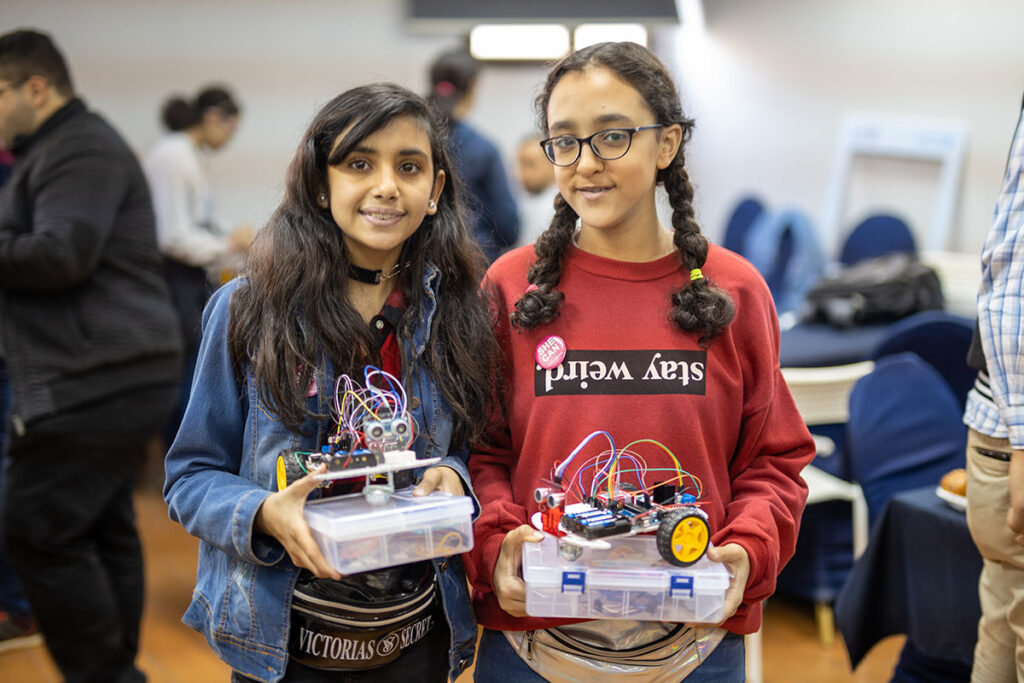From online learning and digital activism to the rapid expansion of high-paying tech jobs, the digital age has generated unprecedented opportunities for the empowerment of women and girls. But advancing technology is also introducing new forms of inequality and heightened threats to their rights and wellbeing.
Women and girls remain underrepresented across the creation, use and regulation of technology. They are less likely to use digital services or enter tech-related careers, and significantly more likely to face online harassment and violence. This limits not only their own digital empowerment but also the transformative potential of technology as a whole—over the past decade, women’s exclusion from the digital sphere has shaved $1 trillion off the GDP of low- and middle-income countries.
In the face of escalating global crises, we stand at a crossroads: allow technology to widen existing disparities and further concentrate power in the hands of the few, or put it to work on behalf of a safer, more sustainable, more equitable future for all.
The choices we make today will profoundly impact our path forward. Here are four steps we can take in the right direction.
1. Close all gaps in digital access and skills
As our daily lives become increasingly digitalised, gender gaps in digital access threaten to leave women and girls even further behind. Though efforts to close these gaps have led to improvements in the gender parity score, the absolute gap between men and women’s access has actually increased by 20 million since 2019. Today, 63 per cent of women have access to the internet, compared to 69 per cent of men. And women are 12 per cent less likely to own a mobile phone, a figure virtually unchanged since before the pandemic.
These global averages don’t tell the whole story: race, age, disability, socioeconomic status and location all play a role in determining women’s digital access and use. Marginalised groups such as older women, rural women and women with disabilities face significantly greater barriers to connectivity. In the least developed countries—where, despite mobile broadband signals covering 76 per cent of the population, only 25 per cent is connected—men are 52 per cent more likely to be within that online minority.
All of which makes clear that bridging access gaps will require more than just better digital infrastructure. Addressing factors like affordability, access to electricity, online privacy and safety, social norms and digital skills and literacy—all of which are mediated by gender—will be key to getting women meaningfully connected.
2. Support women and girls in STEM

Today, women remain a minority in both STEM education and careers, representing only 28 per cent of engineering graduates, 22 per cent of artificial intelligence workers and less than one third of tech sector employees globally. Without equal representation in these fields, women’s participation in shaping technology, research, investments and policy will remain critically limited. The same challenges apply to their access to fast-growing and high-paying careers—an inequality compounded by the fact that, as tech and digital innovation disrupt industries, women will bear the brunt of job losses.
Those who do make it into tech often face an actively hostile environment, with a significant pay gap (21 per cent) and considerably lower rates of promotion (52 women for every 100 men). Nearly half (48 per cent) report experiencing workplace harassment. A whopping 22 per cent say they are considering leaving the workforce altogether due to the treatment they’ve received in the sector.
Providing universal broadband access for teachers, students and schools—and ensuring digital literacy for its users—can increase girls’ exposure to STEM, particularly those from less privileged backgrounds. Digital learning provides new opportunities to adapt educational environments and curricula to the needs of girls and students from marginalised groups.
Working to eliminate gender biases from schools is also key, as is ensuring that girls have access to women mentors in STEM fields with whom they can identify. And connecting STEM to other disciplines—as well as emphasising its potential applications to societal challenges, which research shows is a main driver of girls’ career choices—can help increase girls’ interest as well.
To help women succeed in a changing labour market, targeted reskilling and upskilling programmes should be created, focusing especially on groups most in danger of being left behind. And expanded labour regulations are needed to ensure that labour market transitions improve the position of women, rather than simply reproducing existing inequalities. This includes a living minimum wage, regulations against pay discrimination, and social protection systems that address, for example, discrepancies between the unpaid care burdens of women and men.
3. Create tech that meets the needs of women and girls
Creating more inclusive, less biased tech starts with design and regulation processes rooted in human rights. That means centreing the voices of marginalised and vulnerable women, as well as social and behavioural scientists and human rights experts, in the design of new digital tools. It also means explicitly addressing tensions between the exercise of different rights online, such as freedom of expression vs. right to safety. And it means making ethical frameworks enforceable by grounding them in international human rights standards and norms.
Regulatory reform can’t be left up to the tech sector. Governments need to step in to outline companies’ responsibilities, mandate monitoring mechanisms such as gender impact assessments, and ensure data use transparency through mechanisms like mandatory artificial intelligence audits. At the international level, digital governance will be crucial to ensuring that developing technology is aligned with the common good rather than just with the interests of multinational corporations.
4. Address technology-facilitated gender-based violence

Despite its prevalence and gravity, there is no universally accepted definition of technology-facilitated gender-based violence, but it can be understood as any act of violence committed, assisted or aggravated by the use of ICT on the basis of gender. Though such acts often take place in the virtual sphere, they result in tangible harm—physical, sexual, psychological, social, political and/or economic. This kind of violence doesn’t end when women log off: there’s a continuum between real-world and online violence, with technology helping to perpetuate and heighten surveillance, trafficking and other forms of abuse.
In the online sphere, gender-based violence also forces women and girls to self-censor and deplatform, limiting their ability to engage and participate virtually. As social media becomes an increasingly crucial space for both socialising and organising, it has also become a key site of gendered disinformation, misinformation, sexist hate speech and more—all of which undermine women’s online expression and movement.
Teaching digital citizenship can help cover issues of online violence—while also instilling empathy and ethical digital media use, and teaching boys and men to become advocates for gender equality.
Source: UN Women
How helpful was this article?
Click on a star to rate it!
0 / 5. 0
Be the first to rate this post!
UN Women
Related posts
Subscribe
Receive personalised articles from experts and wellness inspiration weekly!


